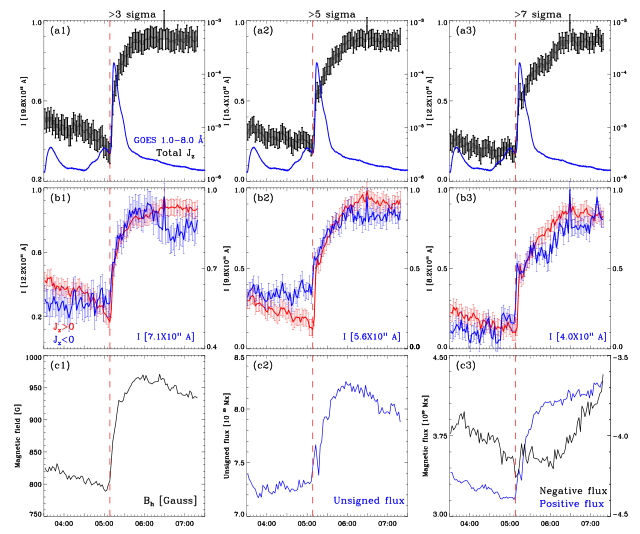

New Insights into Photosphere Currents Through High-Cadence Magnetograms
A research team led by Dr. Shen Jinhua from the Xinjiang Astronomical Observatory of the Chinese Academy of Sciences investigated rapid spatiotemporal vertical electric currents (VECs) during an X flare using the high-cadence magnetograms and Extreme ultraviolet data from Atmospheric Imaging Assembly(AIA)and Helioseismic and Magnetic Imager (HMI) onboard Solar Dynamics Observatory (SDO).
The related results were published in the Astrophysical Journal.
Using HMI vector magnetograms with a high time resolution of 135s,the researcher analyzed the spatiotemporal evolution of photospheric VECs during an X1.1 fare in active region NOAA 11890. Their aim was to understand how magnetic energy is rapidly dissipated from the reconnection-driven corona to the lower atmosphere using high-cadence magnetograms.
“According to the velocity field map, there obviously exist shearing and converging motion (i.e., oppositely directed flows on the two sides of polarity inversion lines) preceding the flare onset, which are located in the light bridge of the sunspot along the strong PILs. These observations suggest that the magnetic fields with sheared motions could be accumulating energy before the fare onset, and the initial current density is more likely to originate from photospheric motions.”, said Dr. SHEN.
The spatial configuration of VEC ribbons is always conjugate footprints, and it takes the form of a sigmoid along two sides of the PIL at the beginning of the flare. The researchers confirmed previous results regarding the rapid and simultaneous increase of VECs associated with flares. Also, the VEC ribbons take the form of a J-shaped confguration, which is expected to be from QSL magnetic reconnection inside a magnetic flux rope. However, they found that the spatial distribution of photospheric VECs, especially, and its temporal evolution are closely correlated with rapid enhancement of horizontal magnetic fields during the flare.
The close correlation is obtained from two observational facts: (1) The positive and negative VEC ribbons appear at the two opposite edges of the enhanced Bh and spread outward along the magnetic PIL. (2) As the two VEC ribbons show a kind of approaching motion toward the center of Bh enhancement. In contrast, the faring loops and white-light fare ribbons have an initial contraction and later expansion motion. The results show that the rapid change of magnetic fields related to flares has a predominant role in affecting the spatiotemporal evolution of VECs.
Figure 1. Panels (a)–(c) display the spatial evolution of the vertical current density Jz in the fare region at different times. Panels (d)–(f) show Bz magnetograms and the horizontal field vectors; the red and yellow contours are the positive and negative VEC density, respectively. Panels (g)–(i) are horizontal field maps in the pre- and post-flare states and their difference image. The PIL is overplotted in panels (f)–(i).
The previous view held that the evolution of the photospheric current ribbons corresponded to the separation movement of the flare ribbons. The observation and calculation results of this study present completely opposite conclusions, providing strong observational evidence for the existing flare theoretical model and current evolution. The results demonstrate that the rapid movement of the photospheric magnetic field during the flare process leads to the converging movement of the current.
This work provides important insights into the evolution of VEC, in particular reporting the approaching motion of VECs during a flare for the first time, according to the referee.
The work was supported by the Strategic Priority Research Program of the Chinese Academy of Sciences, the National Natural Science Foundation of China, the Natural Science Foundation of Xinjiang Uygur Autonomous Region, etc.

Figure 2. The temporal evolution of the total photospheric VECs and magnetic fields is shown in the box region of Figure 1. Panels (a1)–(a3) show the total unsigned photosphere VEC above the threshold values of 3σ, 5σ, and 7σ, respectively. The error bar is 1σ. Panels (b1)–(b3) are the temporal evolution of the positive (red) and negative (blue) VEC, respectively. Panels (c1)–(c3) show the time evolution of these magnetic fluxes and the horizontal field for the region.
Attachment Download: